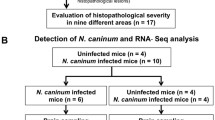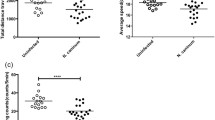Abstract
Neurotoxocarosis is an infection of the central nervous system caused by migrating larvae of the common dog and cat roundworms (Toxocara canis and Toxocara cati), which are zoonotic agents. As these parasites are prevalent worldwide and neuropathological and molecular investigations on neurotoxocarosis are scare, this study aims to characterise nerve fibre demyelination associated with neurotoxocarosis on a molecular level. Transcription of eight myelin-associated genes (Cnp, Mag, Mbp, Mog, Mrf-1, Nogo-A, Plp1, Olig2) was determined in the mouse model during six time points of the chronic phase of infection using qRT-PCR. Expression of selected proteins was analysed by Western blotting or immunohistochemistry. Additionally, demyelination and neuronal damage were investigated histologically. Significant differences (p ≤ 0.05) between transcription rates of T. canis-infected and uninfected control mice were detected for all analysed genes while T. cati affected five of eight investigated genes. Interestingly, 2′, 3 ´-cyclic nucleotide 3′-phosphodiesterase (Cnp) and myelin oligodendrocyte glycoprotein (Mog) were upregulated in both T. canis- and T. cati-infected mice preceding demyelination. Later, CNPase expression was additionally enhanced. As expected, myelin basic protein (Mbp) was downregulated in cerebra and cerebella of T. canis-infected mice when severe demyelination was present 120 days post infectionem (dpi). The transcriptional pattern observed in the present study appears to reflect direct traumatic and hypoxic effects of larval migration as well as secondary processes including host immune reactions, demyelination and attempts to remyelinate damaged areas.




Similar content being viewed by others
References
Baumann N, Pham-Dinh D (2001) Biology of oligodendrocyte and myelin in the mammalian central nervous system. Physiol Rev 81:871–927
Beautyman W, Woolf AL (1951) An ascaris larva in the brain in association with acute anterior poliomyelitis. J Pathol Bacteriol 63:635–647
Beaver PC (1956) Larva migrans. Exp Parasitol 5:587–621
Blakemore WF, Keirstead HS (1999) The origin of remyelinating cells in the central nervous system. J Neuroimmunol 98:69–76
Blennow K, Hardy J, Zetterberg H (2012) The neuropathology and neurobiology of traumatic brain injury. Neuron 76:886–899
Boda E, Pini A, Hoxha E, Parolisi R, Tempia F (2009) Selection of reference genes for quantitative real-time RT-PCR studies in mouse brain. J Mol Neurosci 37:238–253
Cardillo N, Rosa A, Ribicich M, Lopez C, Sommerfelt I (2009) Experimental infection with Toxocara cati in BALB/c mice, migratory behaviour and pathological changes. Zoonoses Publ Health 56:198–205
Dolinsky ZS, Hardy CA, Burright RG, Donovick PJ (1985) The progression of behavioral and pathological effects of the parasite Toxocara canis in the mouse. Physiol Behav 35:33–42
Dousset V, Sibon I, Menegon P (2003) Case no 6. Cerebral vasculitis due to Toxocara canis (or catis) origin. J Radiol 84:89–91
Epe C, Sabel T, Schnieder T, Stoye M (1994) The behavior and pathogenicity of Toxocara canis larvae in mice of different strains. Parasitol Res 80:691–695
Fatemi SH, Reutiman TJ, Folsom TD, Bell C, Nos L, Fried P, Pearce DA, Singh S, Siderovski DP, Willard FS, Fukuda M (2006) Chronic olanzapine treatment causes differential expression of genes in frontal cortex of rats as revealed by DNA microarray technique. Neuropsychopharmacology 31:1888–1899
Finsterer J, Auer H (2007) Neurotoxocarosis. Rev Inst Med Trop Sao Paulo 49:279–287
Fisher M (2003) Toxocara cati: an underestimated zoonotic agent. Trends Parasitol 19:167–170
Fortenberry JD, Kenney RD, Younger J (1991) Visceral larva migrans producing static encephalopathy in an infant. Pediatr Infect Dis J 10:403–406
Georgieva L, Moskvina V, Peirce T, Norton N, Bray NJ, Jones L, Holmans P, Macgregor S, Zammit S, Wilkinson J, Williams H, Nikolov I, Williams N, Ivanov D, Davis KL, Haroutunian V, Buxbaum JD, Craddock N, Kirov G, Owen MJ, O’Donovan MC (2006) Convergent evidence that oligodendrocyte lineage transcription factor 2 (OLIG2) and interacting genes influence susceptibility to schizophrenia. Proc Natl Acad Sci U S A 103:12469–12474
Gleckman AM, Bell MD, Evans RJ, Smith TW (1999) Diffuse axonal injury in infants with nonaccidental craniocerebral trauma: enhanced detection by beta-amyloid precursor protein immunohistochemical staining. Arch Pathol Lab Med 123:146–151
Gould IM, Newell S, Green SH, George RH (1985) Toxocariasis and eosinophilic meningitis. Br Med J (Clin Res Ed) 291:1239–1240
Gregersen R, Christensen T, Lehrmann E, Diemer NH, Finsen B (2001) Focal cerebral ischemia induces increased myelin basic protein and growth-associated protein-43 gene transcription in peri-infarct areas in the rat brain. Exp Brain Res 138:384–392
Hagemeyer N, Goebbels S, Papiol S, Kastner A, Hofer S, Begemann M, Gerwig UC, Boretius S, Wieser GL, Ronnenberg A, Gurvich A, Heckers SH, Frahm J, Nave KA, Ehrenreich H (2012) A myelin gene causative of a catatonia-depression syndrome upon aging. EMBO Mol Med 4:528–539
Haque NS, Buchberg AM, Khalili K (1994) Isolation and characterization of MRF-1, a brain-derived DNA-binding protein with capacity to regulate expression of Myelin Basic Protein gene. J Biol Chem 269:31149–31156
Havasiová-Reiterová K, Tomasovicová O, Dubinský P (1995) Effect of various doses of infective Toxocara canis and Toxocara cati eggs on the humoral response and distribution of larvae in mice. Parasitol Res 81:13–17
Hinks GL, Franklin RJM (1999) Distinctive patterns of PDGF-A, FGF-2, IGF-1 and TGF-β1 gene expression during remyelination of experimentally-induced spinal cord demyelination. Mol Cell Neurosci 14:153–168
Hotez PJ, Wilkins PP (2009) Toxocariasis: America’s most common neglected infection of poverty and a helminthiasis of global importance? PLoS Negl Trop Dis 3:e400
Huang K, Tang W, Tang R, Xu Z, He Z, Li Z, Xu Y, Li X, He G, Feng G, He L, Shi Y (2008) Positive association between Olig2 and schizophrenia in the Chinese Han population. Hum Genet 122:659–660
Israelsson C, Flygt J, Astrand E, Kiwanuka O, Bengtsson H, Marklund N (2014) Altered expression of myelin-associated inhibitors and their receptors after traumatic brain injury in the mouse. Restor Neurol Neurosci 32:717–731
Janecek E, Beineke A, Schnieder T, Strube C (2014) Neurotoxocarosis: marked preference of Toxocara canis for the cerebrum and T. cati for the cerebellum in the paratenic model host mouse. Parasit Vectors 7:194
Janecek E, Wilk E, Schughart K, Geffers R, Strube C (2015) Microarray gene expression analysis reveals major differences between Toxocara canis and Toxocara cati neurotoxocarosis and involvement of T. canis in lipid biosynthetic processes. Int J Parasitol (in press)
Kayes SG (1997) Human toxocariasis and the visceral larva migrans syndrome: correlative immunopathology. Chem Immunol 66:99–124
Knöferle J, Ramljak S, Koch JC, Tönges L, Asif AR, Michel U, Wouters FS, Heermann S, Krieglstein K, Zerr I, Bähr M, Lingor P (2010) TGF-β1 enhances neurite outgrowth via regulation of proteasome function and EFABP. Neurobiol Dis 38:395–404
Kolbeková P, Vĕtvička D, Svoboda J, Skírnisson K, Leissová M, Syruček M, Marečková H, Kolářová L (2011) Toxocara canis larvae reinfecting BALB/c mice exhibit accelerated speed of migration to the host CNS. Parasitol Res 109:1267–1278
Kuhlmann T, Brück W (2010) Oligodendroglial pathology in multiple sclerosis. In: Armati PJ, Mathey EK (eds) The biology of oligodendrocytes, 1st edn. Cambridge University Press, New York, pp 171–185
Kuhlmann T, Remington L, Maruschak B, Owens T, Brück W (2007) Nogo-A is a reliable oligodendroglial marker in adult human and mouse CNS and in demyelinated lesions. J Neuropathol Exp Neurol 66:238–246
Laabs EM, Schnieder T, Strube C (2012) In vitro studies on the sexual maturation of the bovine lungworm Dictyocaulus viviparus during the development of preadult larvae to adult worms. Parasitol Res 110:1249–1259
Liao CW, Cho WL, Kao TC, Su KE, Lin YH, Fan CK (2008a) Blood-brain barrier impairment with enhanced SP, NK-1R, GFAP and claudin-5 expressions in experimental cerebraltoxocariasis. Parasite Immunol 30:525–534
Liao CW, Fan CK, Kao TC, Ji DD, Su KE, Lin YH, Cho WL (2008b) Brain injury-associated biomarkers of TGF-beta1, S100B, GFAP, NF-L, tTG, AbetaPP, and tau were concomitantly enhanced and the UPS was impaired during acute brain injury caused by Toxocara canis in mice. BMC Infect Dis 8:84
Lin KY, Lai SC (2009) Induction of 2′,3′-cyclic nucleotide 3′-phosphodiesterase in demyelination of BALB/c mice caused by Angiostrongylus cantonensis. J Comp Pathol 141:248–253
Lindner M, Heine S, Haastert K, Garde N, Fokuhl J, Linsmeier F, Grothe C, Baumgärtner W, Stangel M (2008) Sequential myelin protein expression during remyelination reveals fast and efficient repair after central nervous system demyelination. Neuropathol Appl Neurobiol 34:105–114
Mikhael NZ, Montpetit VJ, Orizaga M, Rowsell HC, Richard MT (1974) Toxocara canis infestation with encephalitis. Can J Neurol Sci 1:114–120
Moreira-Silva SF, Rodrigues MG, Pimenta JL, Gomes CP, Freire LH, Pereira FE (2004) Toxocariasis of the central nervous system: with report of two cases. Rev Soc Bras Med Trop 37:169–174
Morell P, Barrett CV, Mason JL, Toews AD, Hostettler JD, Knapp GW, Matsushima GK (1998) Gene expression in brain during cuprizone-induced demyelination and remyelination. Mol Cell Neurosci 12:220–227
Nicoletti A (2013) Toxocariasis. In: Garcia HH, Tanowitz HB, Del Brutto OH (eds) Handbook of clinical neurology, 114 (3rd series), 1st edn. Elsevier, Amsterdam, pp 217–228
Prokopic J, Figallová V (1982) Migration of some roundworm species in experimentally infected white mice. Folia Parasitol (Praha) 29:309–313
Richartz E, Buchkremer G (2002) Cerebraltoxocariasis: a rare cause of cognitive disorders. A contribution to differential dementia diagnosis. Nervenarzt 73:458–462
Russegger L, Schmutzhard E (1989) Spinal toxocaral abscess. Lancet 2:398
Schantz PM (1989) Toxocara larva migrans now. Am J Trop Med Hyg 41(Suppl 3):21–34
Seehusen F, Baumgärtner W (2010) Axonal pathology and loss precede demyelination and accompany chronic lesions in a spontaneously occurring animal model of multiple sclerosis. Brain Pathol 20:551–559
Sick C, Hennerici MG (2014) Expect the unexpected: a case of isolated eosinophilic meningitis in toxocariasis. Case Rep Neurol 6:259–263
Sommer C, Ringelstein EB, Biniek R, Glockner WM (1994) Adult Toxocara canis encephalitis. J Neurol Neurosurg Psychiatry 57:229–231
Söndergaard HP, Theorell T (2004) A putative role for Toxocara species in the aetiology of multiple sclerosis. Med Hypotheses 63:59–61
Targett MP, Sussman J, Scolding N, O’Leary MT, Compston DA, Blakemore WF (1996) Failure to achieve remyelination of demyelinated rat axons following transplantation of glial cells obtained from the adult human brain. Neuropathol Appl Neurobiol 22:199–206
Verrier JD, Jackson TC, Gillespie DG, Janesko-Feldman K, Bansal R, Goebbels S, Nave KA, Kochanek PM, Jackson EK (2013) Role of CNPase in the oligodendrocytic extracellular 2′,3′-cAMP-adenosine pathway. Glia 61:1595–1606
Villano M, Cerillo A, Narciso N, Vizioli L, Del Basso De Caro M (1992) A rare case of Toxocara canis arachnoidea. J Neurosurg Sci 36:67–69
Vogel C, Marcotte E (2012) Insights into the regulation of protein abundance from proteomic and transcriptomic analyses. Nat Rev Genet 13:227–232
Yang L, Kan EM, Lu J, Wu C, Ling EA (2014) Expression of 2′,3′-cyclic nucleotide 3′-phosphodiesterase (CNPase) and its roles in activated microglia in vivo and in vitro. J Neuroinflammation 11:148
Zhao C, Fancy SP, Magy L, Urwin JE, Franklin RJ (2005) Stem cells, progenitors and myelin repair. J Anat 207:251–258
Acknowledgments
The authors thank Annika Lehmbecker, PhD, for valuable support in histological photography and Bettina Buck, Petra Grünig and Sabine Händel for excellent technical assistance. Furthermore, the PhD grants of the Society of Friends of the University of Veterinary Medicine Hannover [“Gesellschaft der Freunde der Tierärztlichen Hochschule Hannover” (GdF)] and the Hannover Graduate School for Veterinary Pathobiology, Neuroinfectiology and Translational Medicine (HGNI) for LH are gratefully acknowledged.
Conflict of interest
The authors declare that they have no conflict of interest.
Author information
Authors and Affiliations
Corresponding author
Electronic supplementary material
Below is the link to the electronic supplementary material.
Supplementary Table 1
(DOCX 18 kb)
Supplementary Table 2
(DOCX 17 kb)
Rights and permissions
About this article
Cite this article
Heuer, L., Beyerbach, M., Lühder, F. et al. Neurotoxocarosis alters myelin protein gene transcription and expression. Parasitol Res 114, 2175–2186 (2015). https://doi.org/10.1007/s00436-015-4407-1
Received:
Accepted:
Published:
Issue Date:
DOI: https://doi.org/10.1007/s00436-015-4407-1




